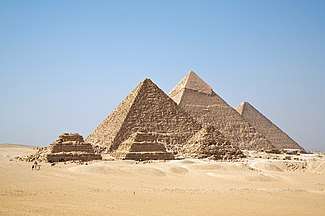Music of Egypt
Music has been an integral part of Egyptian culture since antiquity. The Bible documents the instruments played by the ancient Hebrews, all of which are correlated in Egyptian archaeology. Egyptian music probably had a significant impact on the development of ancient Greek music, and via the Greeks was important to early European music well into the Middle Ages. Egyptian modern music is considered as a main core of Middle Eastern and Oriental music as it has a very big influence on the region due to the popularity and huge influence of Egyptian Cinema and Music industries. The tonal structure of Oriental Middle Eastern music is defined by the maqamat, loosely similar to the Western modes, while the rhythm of Middle Eastern music is governed by the iqa'at, standard rhythmic modes formed by combinations of accented and unaccented beats and rests.
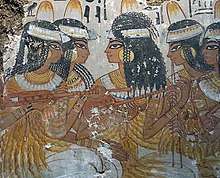
| This article is part of a series on |
| Life in Egypt |
|---|
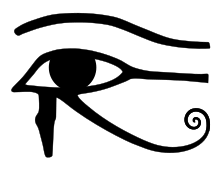 |
| Culture |
|
| Society |
|
| Politics |
|
| Economy |
|
Egypt portal |
History
The ancient Egyptians credited the goddess Bat with the invention of music. The cult of Bat was eventually syncretised into that of Hathor because both were depicted as cows. Hathor's music was believed to have been used by Osiris as part of his effort to civilise the world. The lion-goddess Bastet was also considered a goddess of music.
Neolithic period
In prehistoric Egypt, music and chanting were commonly used in magic and rituals. Rhythms during this time were unvaried and music served to create rhythm. Small shells were used as whistles.[1](pp26–30)
Predynastic period
During the predynastic period of Egyptian history, funerary chants continued to play an important role in Egyptian religion and were accompanied by clappers or a flute. Despite the lack of physical evidence in some cases, Egyptologists theorise that the development of certain instruments known of the Old Kingdom period, such as the end-blown flute, took place during this time.[1](pp33–34)
Old Kingdom
The evidence for instruments played is more securely attested in the Old Kingdom when harps, flutes and double clarinets were played. Percussion instruments and lutes were added to orchestras by the Middle Kingdom. Cymbals frequently accompanied music and dance, much as they still do in Egypt today.
Typically ancient Egyptian music was composed from the phrygian dominant scale, phrygian scale, double harmonic scale (Arabic scale) or lydian scale. The phrygian dominant scale may often feature an altered note or two in parts to create tension. For instance the music could typically be in the key of E phrygian dominant using the notes E, F, G sharp, A, B, C, D and then have an A sharp, B, A sharp, G natural and E to create tension.
Medieval music
Early Middle Eastern music was influenced by Byzantine and Persian forms, which were themselves heavily influenced by earlier Greek, Semitic, and Ancient Egyptian music.
Egyptians in Medieval Cairo believed that music exercised "too powerful an effect upon the passions, and leading men into gaiety, dissipation and vice." However, Egyptians generally were very fond of music. Though, according to E.W. Lane, no "man of sense" would ever become a musician, music was a key part of society. Tradesmen of every occupation used music during work and schools taught the Quran by chanting.[2](p359)
The music of Medieval Egypt was derived from Greek and Persian traditions. Lane said that "the most remarkable peculiarity of the Arab system of music is the division of tones into thirds," although today Western musicologists prefer to say that Arabic music's tones are divided into quarters. The songs of this period were similar in sound and simple, within a small range of tones. Egyptian song, though simple in form, is embellished by the singer. Distinct enunciation and a quavering voice are also characteristics of Egyptian singing.[2](pp360–361)
Male professional musicians during this period were called Alateeyeh (plural), or Alatee (singular), which means "a player upon an instrument". However, this name applies to both vocalists as well as instrumentalists. This position was considered disreputable and lowly. However, musicians found work singing or playing at parties to entertain the company. They generally made three shillings a night, but earned more by the guests' givings.
Female professional musicians were called Awalim (pl) or Al’meh, which means a learned female. These singers were often hired on the occasion of a celebration in the harem of a wealthy person. They were not with the harem, but in an elevated room that was concealed by a screen so as not to be seen by either the harem or the master of the house. The female Awalim were more highly paid than male performers and more highly regarded than the Alateeyeh as well. Lane relates an instance of a female performer who so enraptured her audience that she earned up to fifty guineas for one night's performance from the guests and host, themselves not considered wealthy.
Modern Egyptian classical and pop music
In the second half of the 19th century, the Hasaballah genre of popular improvisational brass band folk music emerged, initiated by clarinettist Mohammad Hasaballah and his band, also called Hasaballah, playing in Cairo's music and entertainment quarter on Mohammed Ali Street. The typical line-up of trumpet, trombone, bass and snare drums, was popular, such as at family events, for well over a century, and is still played.[3][4]
Egyptian music began to be recorded in the 1910s when Egypt was still part of the Ottoman Empire. The cosmopolitan Ottomans encouraged the development of the arts, encouraging women and minorities to develop their musical abilities. By the fall of the Empire, Egypt's classical musical tradition was already thriving, centered on the city of Cairo. In general, modern Egyptian music blends its indigenous traditions with Turkish and western elements.
Since the end of World War I, some of the Middle East's biggest musical stars have been Egyptian. Contemporary Egyptian music traces its beginnings to the creative work of luminaries such as Abdu-l Hamuli, Almaz and Mahmud Osman, who were all patronized by the Ottoman Khedive Ismail, and who influenced the later work of the 20th century's most important Egyptian composers: Sayed Darwish, Umm Kulthum, Mohammed Abdel Wahab, Abdel Halim Hafez, and Zakariya Ahmed. Most of these stars, including Umm Kulthum and Nagat El-Saghira, were part of the traditional Egyptian music. Some, like Abd el-Halim Hafez, were associated with the Egyptian nationalist movement from 1952 onward.
Cairo-born Fatma Said was the first Egyptian soprano to sing at the Teatro alla Scala, Milan,[5] and from 2016-2018 took part in BBC Radio 3 New Generation Artists scheme.[6]
Western classical music
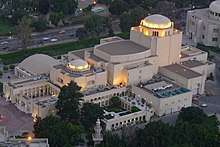
Western classical music was introduced to Egypt, and, in the middle of the 18th century, instruments such as the piano and violin were gradually adopted by Egyptians. Opera also became increasingly popular during the 18th century, and Giuseppe Verdi's Egyptian-themed Aida was premiered in Cairo on December 24, 1871.
By the early 20th century, the first generation of Egyptian composers, including Yusef Greiss, Abu Bakr Khairat, and Hasan Rashid, began writing for Western instruments. The second generation of Egyptian composers included notable artists such as Gamal Abdelrahim. Representative composers of the third generation are Ahmed El-Saedi and Rageh Daoud. In the early 21st century, even fourth generation composers such as Mohamed Abdelwahab Abdelfattah (of the Cairo Conservatory) have gained international attention.
Religious music in Egypt
Religious music remains an essential part of traditional Sufi Muslim and Coptic Christian celebrations called mulids. Mulids are held in Egypt to celebrate the saint of a particular church. Muslim mulids are related to the Sufi zikr ritual. The Egyptian flute, called the ney, is commonly played at mulids. The liturgical music of the Alexandrian Rite also constitutes an important element of Egyptian music and is said to have preserved many features of ancient Egyptian music.
Folkloric music
Egyptian folk music, including the traditional Sufi dhikr rituals, are the closest contemporary music genre to ancient Egyptian music, having preserved many of its features, rhythms and instruments.[7][8]
Folk and roots revival
The 20th century has seen Cairo become associated with a roots revival. Musicians from across Egypt are keeping folk traditions alive, such as those of rural Egyptians (fellahin), the Saii'da, and to a lesser extent minorities like the Siwa people, the Egyptian Gypsies, the Sinawis and the Nubians. Mixtures of folk and pop have also risen from the Cairo hit factory.
Since the Nasser era, Egyptian pop music has become increasingly important in Egyptian culture, particularly among the large youth population of Egypt. Egyptian folk music continues to be played during weddings and other traditional festivities. In the last quarter of the 20th century, Egyptian music was a way to communicate social and class issues. Among some of the most popular Egyptian pop singers today are Mohamed Mounir and Amr Diab.
Sawahli (coastal) music is a type of popular Egyptian music from the country's northern coast, and is based around ancient Egyptian instrumentals, mainly the simsimiyya, which is an indigenous stringed instrument. Well-known singers include Abdo El-Iskandrani and Eid El-Gannirni.
Saidi (Upper Egyptian)
Egyptian musicians from Upper Egypt play a form of folk music called Ṣa‘īdi which originates from Upper Egypt). Discovered in 1975 by Alain Weber, Metqal Qenawi's Les Musiciens du Nil ( Musicians of the Nile) are the most popular saidi group, and were chosen by the government to represent Egyptian folk music abroad. They spent over three decades touring Europe performing at various festivals and musical events and in 1983 after their performance in the World of Music and Dance Festival, they were signed to Peter Gabriel's label Real World-Carolina and went on to feature on his Album Passion. Other performers include Shoukoukou, Ahmad Ismail, Omar Gharzawi, Sohar Magdy and Ahmed Megahid.
Nubian
In Egypt, Nubians are native to southern part of Aswan, though some live in Cairo, Alexandria and other cities. Nubian folk music can still be heard, but migration and intercultural contact with Egyptian and other musical genres have produced new innovations. Ali Hassan Kuban's efforts had made him a regular on the world music scene, while Mohamed Mounir's social criticism and sophisticated pop have made him a star among Nubians, Egyptians, and other people worldwide. Ahmed Mounib, Mohamed Mounir's mentor, was by far the most notable Nubian singer to hit the Egyptian music scene, singing in both Egyptian Arabic as well as in his native Nobiin. Hamza El Din was another popular Nubian Egyptian artist, well known on the world music scene and has collaborated with the Kronos Quartet.
Egyptian musical instruments
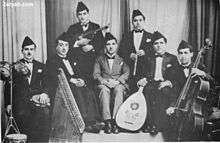
During the Abbasid and Ottoman dynasty Egypt was one of the main musical hubs in the middle east and therefore after the fall of the Ottoman Empire in 1923 Egypt became the capital of Arabic music where classical instruments such as the oud, qanun and ney were widely used. The typical takht (ensemble) consisted of an Oud player, qanun player, ney player and violin player. The takht (literally meaning a sofa) was the most common form of ensembles in the early 20th century before the adoption of more orchestral instruments which were introduced by composers such as Mohamed El Qasabgi, Riad El Sunbati and Mohammed Abdel Wahab.
Electronic music
One of the most respected early electronic music composers, Halim El-Dabh, is an Egyptian. However, the Egyptian electronic music scene has only gained a mainstream foothold recently in the form of techno, trance and dance pop DJs such as Aly & Fila. In the 2010s, Shaabi music, a form of electronic music which often contains political lyrics, gained popularity both inside and outside music.[9]
Reconstruction of ancient Egyptian music
In the early 21st century, interest in the music of the pharaonic period began to grow, inspired by the research of such foreign-born musicologists as Hans Hickmann. By the early 21st century, Egyptian musicians and musicologists led by the musicology professor Khairy El-Malt at Helwan University in Cairo had begun to reconstruct musical instruments of Ancient Egypt, a project that is ongoing.[10]
_-_TIMEA.jpg) Broken Egyptian Sistrum
Broken Egyptian Sistrum- Egyptian Sistrum
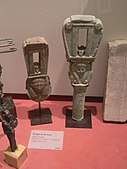 Collection of sistrums at the Louvre
Collection of sistrums at the Louvre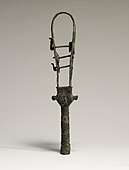 From the Walters Art Museum, 380–250 BC
From the Walters Art Museum, 380–250 BC- Ancient Egyptian Long Flute
- Ancient Egyptian Stringed Instruments
- Ancient Egyptian With TwoSided Drum
- Ancient Egyptian Music Band
- Late Style Egyptian Lyre
- Ancient Egyptian Woman Playing Drum
- Egyptian Lyre
See also
Notes and references
- Pérez-Arroyo, Rafael (2003). Egypt: Music in the Age of the Pyramids (1st ed.). Madrid: Centro de Estudios Egipcios. p. 28. ISBN 8493279617.
- Lane, Edward William (2003). An Account of the Manners and Customs of the Modern Egyptians: The Definitive 1860 Edition. Cairo: American University in Cairo Press. ISBN 9789774247842.
- Egypt: Hasaballah, the People's Music, Al Jazeera, 22 Nov 2017
- Hasaballah Music: The Past and The Present Archived 2017-01-08 at the Wayback Machine, The Community Times, 24 May 2016
- "Fatma Said". The American University in Cairo. Retrieved 10 May 2020.
- "Fatma Said Biography (BBC)". BBC. Retrieved 10 May 2020.
- Hickmann, Hans (1957). "Un Zikr Dans le Mastaba de Debhen, Guizah (IVeme Dynastie)". Journal of the International Folk Music Council. 9: 59–62. doi:10.2307/834982.
- Hickmann, Hans (January 1960). "Rythme, mètre et mesure de la musique instrumentale et vocale des anciens Egyptiens". Acta Musicologica. 32 (1): 11–22. doi:10.2307/931818.
- "Six Explosive Tracks that Define Mahraganat, Egypt's Wildly Popular Street Music". Thump. Retrieved 2017-05-23.
- Ancient Egyptian Music Symposium
Further reading
- Lodge, David and Bill Badley. "Partner of Poetry". 2000. In Duane, Orla; McConnachie, James (2000). Broughton, Simon; Ellingham, Mark (eds.). World Music, Vol. 1: Africa, Europe and the Middle East. London: Rough Guides. pp. 323–31. ISBN 1-85828-636-0.
- Marcus, Scott L. (2007). Music in Egypt. New York: Oxford University Press. ISBN 0-19-514645-X.
External links
- Audio clips: Traditional music of Egypt. Musée d'ethnographie de Genève. Accessed November 25, 2010. (in French)
- Egyptian music and dance Books
- Ghostly Echoes: an essay on Egypt and its contemporary music! An essay on Egypt and its contemporary music- drummers of the nile
- Church Hymns-coptic multimedia library ترانيم كنسية - مكتبة الوسائط المتعددة القبطية
